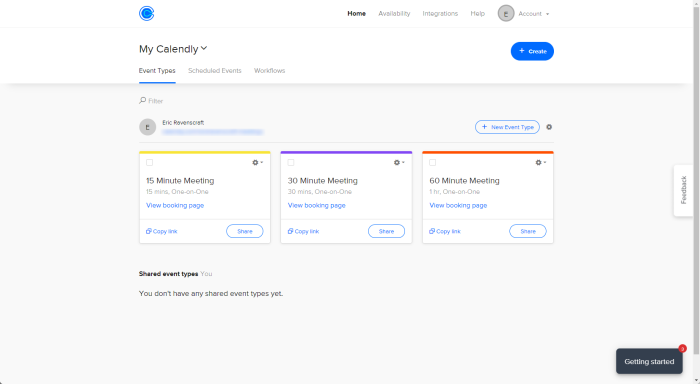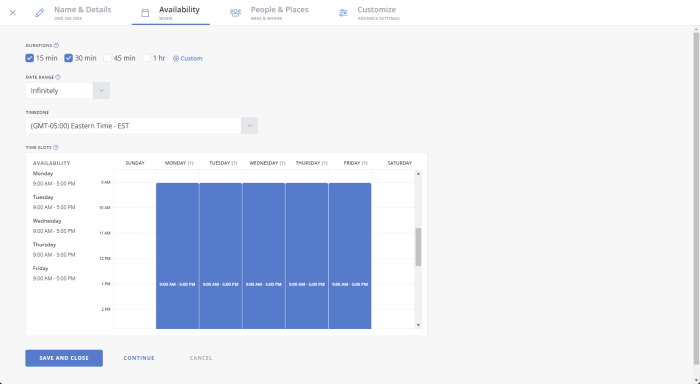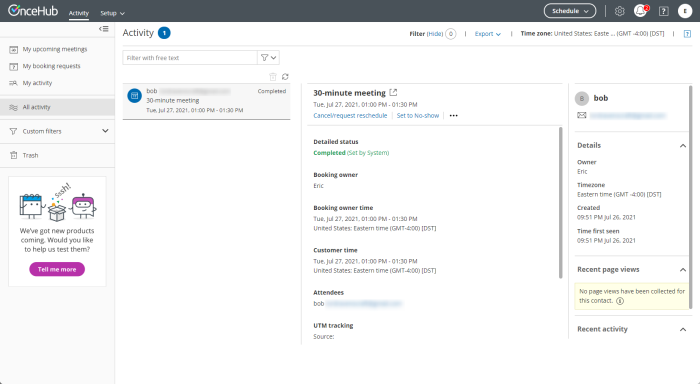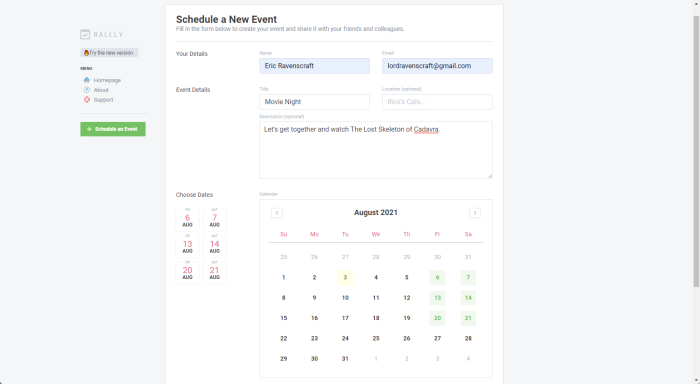In the movies, scheduling is as simple as “see you there at 8.” In real life, it’s a more complicated mess of email, texts, and back-and-forth calls, trying to find the one spot in everyone’s calendar that aligns. Meeting schedulers exist to take the pain out of this process.
Spend less time on meeting prep
Meeting scheduler apps typically let you connect your own calendar, automatically find when you’re busy and when you’re free, and let other people pick the time in your schedule that works best for them. If you need to coordinate a large meeting with many people, these apps can let every participant vote on when is best for them and present the options that are best for the greatest number of people.
We looked at dozens of web- and app-based meeting schedulers to find the software that can help you take the guesswork out of setting up meetings, and these are the eight best tools we found.
The 8 best meeting schedulers
Once you pick your app, make the most of it by automating your meeting scheduling. Here are 4 scheduling automation workflows to make meetings easy, including things like getting meeting notifications in your app of choice, getting all new meeting attendees into your CRM, or automatically sending follow-up emails after a meeting.
What makes a great meeting scheduler?
As we tested meeting scheduler apps, we narrowed down our recommendations according to some key criteria. Here’s a look at what’s important:
-
Ease of use. There are two groups of people that use a meeting scheduler: the event organizer and the people responding to it. A good meeting scheduler should be easy for both groups to use.
-
Integrations with other apps/services. Primarily, you’ll need to connect a meeting scheduler to your calendar application, so the more calendar services an app supports the better. We also gave extra weight to apps that integrated well with project management software as well as automation tools like Zapier.
-
Ability to automatically set up video calls. Being able to quickly hop on a video call with people is more important than ever. Many meeting schedulers can not only add events to your calendar, but also generate links for video chats through common services like Zoom, Google Meet, and Microsoft Teams.
-
Appointment reminders and follow-ups. While a meeting scheduler might integrate with your calendar, there’s no guarantee that any of your attendees will get a reminder to show up on time. Good meeting schedulers will be able to remind everyone that their meeting is coming up, and some will even allow you to automatically send follow-up emails with summaries of your meeting.
-
Value for money. Usually, the core meeting scheduler features will be free for a certain number of users, but extra features like reminders, video call setup, automation, or even scheduling multiple meetings will be part of a subscription. We weighed how much value these tools offered versus the cost of their paid plans.
Best meeting scheduler for letting others schedule meetings with you
Calendly (Web)

Calendly lets other people schedule meetings with you by showing them your availability and offering them different types of meetings they can book with you. It’s an ideal app for anyone who gets a lot of meeting requests and needs a simple but clear reply.
You start by giving Calendly insight into when you’re free by connecting it to your calendar (Google Calendar, iCal, Microsoft Office 365, or Outlook). Then you create different meeting options for the types of meetings you offer, such as “30-minute phone interview” or “initial client intake meeting.” Calendly has a slew of details you can add to each meeting type you offer. Finally, you send a link to people who need to schedule meetings with you so that they can see when you’re available and request the meetings they need. A free plan supports one type of meeting, but starting on the Premium plan, you can make as many types of meetings as you need.
Calendly syncs all the confirmed appointments to your calendar and offers to create an event on your invitees’ calendars as well. There are tools for setting up an automatic reminder email to attendees, too.
While Calendly works well for scheduling meetings with individuals or team members within an organization, its custom events and outgoing links make it ideal for connecting with external clients, customers, and colleagues. Calendly has extensive integration options, including Salesforce, HubSpot, Zoom, GoToMeeting, and Zapier, but you do need to subscribe to a paid plan to get the full benefits here.
By connecting Calendly to Zapier, you can do things like create new Zoom meetings whenever a new meeting is scheduled or add new meeting attendees to your email marketing list. Here are some examples to get started with, but you can customize the workflow to use your favorite apps.
Calendly Pricing: Free with limited features; paid plans from $8/month
Best free meeting scheduler built into a calendar app
Calendar (Web, iOS, Android)

Calendar is more than a meeting scheduler: it’s a full-fledged calendar app. It offers web and mobile versions, and the whole interface feels very reminiscent of Google Calendar. It also offers meeting scheduler features, like creating customizable time slots and shareable booking links.
However, where Google puts some of its best appointment scheduling tools behind a paywall, Calendar gives them away for free. You can create up to two customizable scheduling time slots with the free plan, and connect the app to one of your existing calendar services.
Where Calendar stands out from the crowd is its extensive statistics section. It tracks every one of your meetings, spotting where trends develop. Besides obvious stats like how long you’ve spent in meetings over the past day, week, month, or even year, it also spots attendance records, noting what percentage of people rejected or missed a meeting. It even highlights who you’re most likely to have meetings with. It’s the kind of thing that could be immensely useful when trying to work toward better engagement. And it’s all bundled up in a neat overview section that’s attractive and informative.
Using yet another calendar app might feel a little redundant, but if you want to analyze your meetings in depth and get some meeting scheduling without shelling out money, this is the place to go.
When you connect Calendar to Zapier, you can do things like get Slack notifications whenever someone schedules a new meeting with you, or even add every meeting to a new row in Google Sheets.
Calendar pricing: Free; from $10/month for more connected calendars and scheduling time slots
Best meeting scheduler for scheduling multiple meeting types
CalendarHero (Web)

CalendarHero (formerly Zoom.ai) is similar to Calendly, in that you can create different meeting types of varying durations and share links so people can schedule meetings with you. You can integrate it with your calendar so it automatically learns when you’re free, or you can manually set availability.
The service also comes with a litany of features to customize your event, including adding location details (if you’re meeting in a physical location) or video conferencing details (if you’re meeting online). If you use Google or Microsoft single sign-on to log in to your CalendarHero account, then it can automatically create video chat meetings without any extra setup.
If you upgrade to one of CalendarHero’s paid plans—starting at $8/month—you can get additional features like the ability to collect payments for your events, or get more than two meeting reminders per month.
CalendarHero has a lot of overlap with Calendly, but it comes with more built-in meeting types in the free tier and has a few more tools for customizing your meeting details. If you’re looking for a step up to manage all the various kinds of meetings you need to schedule, CalendarHero is a great option.
By connecting CalendarHero to Zapier, you can automatically add people who schedule a meeting with you to your email marketing list, or send yourself a text whenever you get a new meeting request.
CalendarHero Pricing: Free with limited features, paid plan from $8/month
Best free meeting scheduler
ScheduleOnce (Web)

ScheduleOnce, by OnceHub, lets you create multiple meeting types—including the default 15-, 30-, and 60- minute meeting types—and share one link that guests can use to schedule a meeting with you. Then, people can pick a date and one of your available time slots to book an appointment.
So yes, it’s similar to many of the other services we tested, but what makes it stand out is that it has one of the most generous free tiers among all the meeting scheduler apps we looked at. It’s free for up to 25 users, you can create unlimited meetings and meeting types, and even sync with various video meeting services.
This app syncs with Google Calendar, iCloud, and all of Microsoft’s calendar services, including Exchange, Outlook, and Office 365. For video conferencing, it can also connect to Zoom, Google Meet, Microsoft Teams, GoToMeeting, and Webex Meetings. On top of being a wider list of video services than many of the other apps we tested, this is also included in the free tier.
If you want to upgrade to the paid tiers, you can get unlimited users, integration to tools like Salesforce, and the ability to customize the branding for your meeting schedule pages. At that point, you’re almost certainly looking at corporate use cases.
You can get even more out of ScheduleOnce by connecting it to Zapier. With these integrations, you can do things like email your customers with a Zoom link whenever new meetings are scheduled or create new contacts in HubSpot from your bookings.
ScheduleOnce Pricing: Free for 25 user licenses; paid plans from $9/month per user license
Best free meeting scheduler for quickly picking a date
Rallly (Web)

Show of hands: Who’s available Monday? How about Tuesday? That’s the concept behind the very simple web app Rallly—yes, with three L’s—which helps you and your associates find an agreeable date to get together.
There’s an elegant simplicity to a tool that does one thing and does it well. Rally lets everyone—including the person who set up the poll—submit their answers completely anonymously. There’s no need to create accounts, and only the organizer needs to submit an email address. The site promises that your data is “never used for any commercial purposes,” and the project is open source, so it’s possible to inspect the code.
You enter a few suggestions for when you’d like to meet and invite people to answer your poll by either entering their email addresses or sending them a link. For every poll you create, a discussion box appears below it where anyone can leave comments.
The main drawback to Rallly is it only lets you suggest dates, not times. It doesn’t have any management tools or advanced scheduling features, either, let alone connectivity with your calendar. But sometimes simpler is better. If you and your friends just need a way to schedule a movie night, this is the way to go.
Rallly Pricing: Free
Best meeting scheduler for organizing meetings anonymously
When2meet (Web)

When2meet isn’t much to look at, but if you want to plan a meet-up with people without handing over a single piece of personal information, there are no better options online. This tool lets you anonymously create an event, set available dates and times, and then share the link to the event with anyone else.
When someone else clicks the link, they’ll come to the event page where they can enter their name—or any name if they want to be super careful—and mark when, out of the available time slots, they’re available. Hovering over a time slot will show which people are available and which ones aren’t.
Of course, this complete anonymity means that there’s no way to verify that anyone who responds is who they say they are. If you’re just planning an event with your friends who you trust, that should be fine, though. However, users can enter a password along with their name so that they, and only they, can come back and change their answers later.
When2meet is entirely free, although the site includes a donation link if you feel like tossing a few bucks to the developer.
When2meet Pricing: Free
Best meeting scheduler you already own
Google Calendar (Web, iOS, Android)

If you already have a Google account like everyone else on the planet, that gives you access to one of the most straightforward meeting schedulers out there: Google Calendar. When you create an event, add your guests and click Find a time—then Google does all the hard work. It will show you each person’s calendar side-by-side and even offer suggested times, letting you know how many people in the group can make each time slot. It’s the only solution you need if you’re trying to schedule meetings with people within your organization.
Google has also recently stepped up its game when it comes to more advanced scheduling tools. The new Google Workspace Individual plan—which starts at $10/month—includes advanced appointment scheduling tools like a booking page you can share with others. This lets anyone with an email address create an appointment with you, which shows up directly in your Google Calendar, no third-party services required.
Google Calendar integrates tightly with all other Google apps, and because Google probably already has all your contacts and valuable information stored anyway, there’s no added security risk. But the best part is that you won’t need a new app—Google Calendar is already there.
When you use Google Calendar with Zapier, you can do things like automatically create to-do list items whenever you have a new meeting, or get notifications in your chat app when a meeting is about to start. Learn more about the most popular and useful ways to automate Google Calendar.
Google Calendar pricing: Free for basic scheduling, $10/month for Google Workspace with appointment tools
Best meeting scheduler app for detailed meeting invites
Arrangr (Web)

The downside to a lot of meeting scheduler apps is that they often require access to your calendar, which can be a pretty big privacy concern. Some of the tools we tested even asked for permission to delete entire calendars. While this can be normal for some services, it would be understandable if you’re not comfortable taking that step. Arrangr agrees, and it offers a unique guest mode that can help bridge that confidence gap.
Go to Arrangr’s site, click Start Now (Free), and the service will ask if you want to try setting up events in guest mode. You’ll then be walked through a wizard that will help you set up every detail of your event, including who you want to invite, what time slots are available, and where the event will take place (online or in person).
You still have to enter an email address when you’re done, so it’s not the most private tool online, but it offers a ton of features to customize every detail of your appointments. Its free tier offers unlimited 1:1 meetings, unlimited group meetings (for up to 15 recipients), and one booking page.
Paid tiers start at $4/month and offer more booking pages and more group meeting recipients. Combined with the guest mode, that makes Arrangr one of the most friendly services to new users who want to ease into using a meeting scheduler more regularly.
You can connect Arrangr to Zapier to get even more out of the service: automatically take action when you create events, receive an event invitation, or receive an RSVP to your events.
Arrangr pricing: Free, from $4/month for more group meeting recipients and more booking pages
Make meetings better
The right meeting scheduler helps you get meetings onto your calendar quickly and efficiently. You can keep the productivity going by automating your scheduling workflows and even automating meeting action items. That way, it’s not just the scheduling that’s a breeze, but the entire process that follows.
This article was originally published in January 2019 by Jill Duffy and has had contributions from Jennifer Allen.
[adsanity_group align=’alignnone’ num_ads=1 num_columns=1 group_ids=’15192′]
Need Any Technology Assistance? Call Pursho @ 0731-6725516







